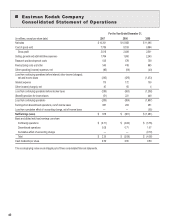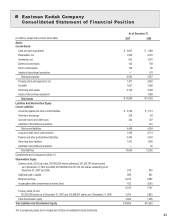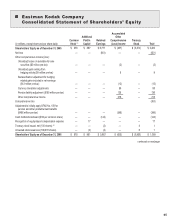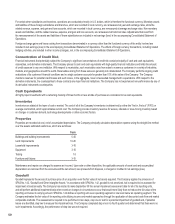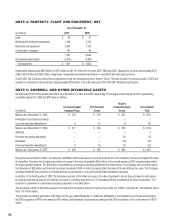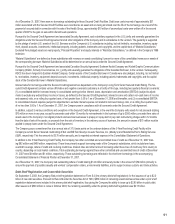Kodak 2007 Annual Report Download - page 53
Download and view the complete annual report
Please find page 53 of the 2007 Kodak annual report below. You can navigate through the pages in the report by either clicking on the pages listed below, or by using the keyword search tool below to find specific information within the annual report.52
Research and Development Costs
Research and development (R&D) costs, which include costs in connection with new product development, fundamental and exploratory research,
process improvement, product use technology and product accreditation, are charged to operations in the period in which they are incurred. In connection
with a business combination, the purchase price allocated to research and development projects that have not yet reached technological feasibility and for
which no alternative future use exists is charged to operations in the period of acquisition.
Advertising
Advertising costs are expensed as incurred and included in selling, general and administrative expenses in the accompanying Consolidated Statement of
Operations. Advertising expenses amounted to $394 million, $366 million, and $460 million in 2007, 2006 and 2005, respectively.
Shipping and Handling Costs
Amounts charged to customers and costs incurred by the Company related to shipping and handling are included in net sales and cost of goods sold,
respectively, in accordance with EITF Issue No. 00-10, “Accounting for Shipping and Handling Fees and Costs.”
Impairment of Long-Lived Assets
The Company applies the provisions of SFAS No. 144, “Accounting for the Impairment or Disposal of Long-Lived Assets.” Under the guidance of SFAS
No. 144, the Company reviews the carrying values of its long-lived assets, other than goodwill and purchased intangible assets with indefinite useful
lives, for impairment whenever events or changes in circumstances indicate that the carrying values may not be recoverable. The Company assesses the
recoverability of the carrying values of long-lived assets by first grouping its long-lived assets with other assets and liabilities at the lowest level for which
identifiable cash flows are largely independent of the cash flows of other assets and liabilities (the asset group) and, secondly, by estimating the undis-
counted future cash flows that are directly associated with and that are expected to arise from the use of and eventual disposition of such asset group.
The Company estimates the undiscounted cash flows over the remaining useful life of the primary asset within the asset group. If the carrying value of the
asset group exceeds the estimated undiscounted cash flows, the Company records an impairment charge to the extent the carrying value of the long-lived
asset exceeds its fair value. The Company determines fair value through quoted market prices in active markets or, if quoted market prices are unavail-
able, through the performance of internal analyses of discounted cash flows.
In connection with its assessment of recoverability of its long-lived assets and its ongoing strategic review of the business and its operations, the Company
continually reviews the remaining useful lives of its long-lived assets. If this review indicates that the remaining useful life of the long-lived asset has
changed significantly, the Company adjusts the depreciation on that asset to facilitate full cost recovery over its revised estimated remaining useful life.
Derivative Financial Instruments
The Company accounts for derivative financial instruments in accordance with SFAS No. 133, “Accounting for Derivative Instruments and Hedging
Activities.” All derivative instruments are recognized as either assets or liabilities and are measured at fair value. Certain derivatives are designated and
accounted for as hedges. The Company does not use derivatives for trading or other speculative purposes.
Income Taxes
In July 2006, the Financial Accounting Standards Board (FASB) issued FASB Interpretation No. 48, “Accounting for Uncertainty in Income Taxes” (FIN 48).
FIN 48 clarifies the accounting and reporting for uncertainty in income taxes recognized in accordance with SFAS No. 109, “Accounting for Income Taxes.”
This Interpretation prescribes a recognition threshold and measurement attribute for financial statement recognition and measurement of a tax position
taken or expected to be taken in a tax return, and also provides guidance on various related matters such as derecognition, interest and penalties, and
disclosure. The adoption of FIN 48 in the first quarter of 2007 did not have a material impact on the Company’s Consolidated Financial Statements.
The Company accounts for income taxes in accordance with SFAS No. 109. The asset and liability approach underlying SFAS No. 109 requires the recog-
nition of deferred tax liabilities and assets for the expected future tax consequences of temporary differences between the carrying amounts and tax basis
of the Company’s assets and liabilities. Management provides valuation allowances against the net deferred tax asset for amounts that are not considered
more likely than not to be realized. For discussion of the amounts and components of the valuation allowances as of December 31, 2007 and 2006, see
Note 16, “Income Taxes.”


